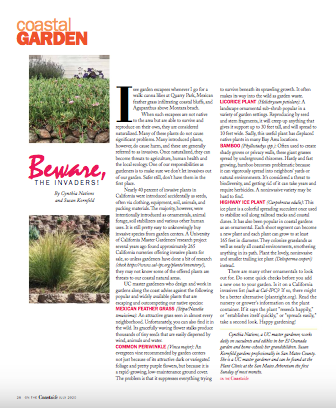I see garden escapees whenever I go for a walk: canna lilies at Quarry Park, Mexican Feather Grass infiltrating coastal bluffs, and Agapanthus above Montara beach. When such escapees are not native to the area but are able to survive and reproduce on their own, they are considered naturalized. Many of these plants do not cause significant problems. Many introduced plants, however, do cause harm, and these are generally referred to as invasives. Once naturalized, they can become threats to agriculture, human health, and the local ecology. One of our responsibilities as gardeners is to make sure we don't let invasives out of our garden. Safer still, don't have them in the first place.
Nearly forty percent of invasive plants in California were introduced accidentally as seeds, often via clothing, equipment, soil, animals, and packing materials. The majority, however, were intentionally introduced as ornamentals, animal forage, soil stabilizers, and various other human uses. It is still pretty easy to unknowingly buy invasive species from garden centers. A UC Master Gardeners research project several years ago found approximately 265 California nurseries offering invasive plants for sale, so unless gardeners have done a bit of research, they may not know some of the offered plants are threats to our coastal natural areas.
UC Master Gardeners who design and work in gardens along the coast advised against the following popular and widely available plants that are escaping and outcompeting our native species:
- Mexican feathergrass (Stipa/Nasselia tenuissima): An attractive grass seen in almost every neighborhood. Unfortunately, you can also find it in the wild. Its gracefully waving flower stalks produce thousands of tiny seeds that are easily dispersed by wind, animals, and water.
- Common Periwinkle (Vinca major): An evergreen vine recommended by garden centers not just because of its attractive dark or variegated foliage and pretty purple flowers, but because it is a rapid-growing, low maintenance ground cover. The problem is that it suppresses everything trying to survive beneath its sprawling growth. It often makes its way into the wild as garden waste.
- Licorice Plant (Helichrysum petiolare): A landscape ornamental sub-shrub popular in a variety of garden settings. Reproducing by seed and stem fragments, it will creep up anything that gives it support up to 30 feet tall, and will spread to 10 feet wide. Sadly, this useful plant has displaced native plants in many Bay Area locations.
- Bamboo (Phyllostachys spp.): Often used to create shady groves or privacy walls, these giant grasses spread by underground rhizomes. Hardy and fast growing, bamboo becomes problematic because it can vigorously spread into neighbors' yards or natural environments. It's considered a threat to biodiversity, and getting rid of it can take years and require herbicides. A non-invasive variety may be hard to find.
- Highway Iceplant (Carpobrotus edulis): This iceplant is a colorful spreading succulent once used to stabilize soil along railroad tracks and coastal dunes. It has also been popular in coastal gardens as an ornamental. Each shoot segment can become a new plant and each plant can grow to at least 165 feet in diameter. They colonize grasslands as well as nearly all coastal environments, smothering anything in its path. Plant the lovely, non-invasive and smaller trailing iceplant (Delosperma cooperi) instead.
There are many other ornamentals to look out for. Do some quick checks before you add a new one to your garden. Is it on a California invasives list (such as Cal-IPC)? If so, there might be a better alternative (plantright.org). Read the nursery or grower's information on the plant container. If it says the plant "reseeds happily," or "establishes itself quickly," or "spreads easily," take a second look. Happy gardening!
Cynthia Nations, a UC Master Gardener, works daily on succulents and edibles in her El Granada garden and home-schools her grandchildren. Susan Kornfeld gardens professionally in San Mateo County. She is a UC Master Gardener and can be found at the Plant Clinic at the San Mateo Arboretum the first Sunday of most months.
Attached Images:
